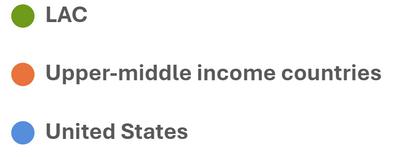

Economic pulse of the Americas: How dependent is Latin America on taxes on international trade?
The economies of Latin America and the Caribbean (LAC) historically have relied more on taxes on international trade than peer upper-middle-income countries. The challenge is that further reducing barriers to trade (essential for investment) also has implications for balancing government spending.
Taxes on international trade as a percent of revenue (1998 vs. 2023)
Share of revenue
Although much progress has been made in reducing duties since the liberalization reforms of the 1990s, some countries still rely more on duties on imports and exports than their income peers, but that varies greatly country by country. So, how do different countries compare in their reliance on those s as a source of revenue?


Source: IMF Government Finance Statistics Yearbook and related data files
Notes: Includes both taxes on imports as well as exports and other indirect duties as a percent of government revenue
Which countries are the most reliant on taxes from trade? Higher import duties tend to coincide with greater fiscal dependence on trade-related taxes (which include both import and export duties).
Taxes on international trade (percent of government revenue) and import duties on global imports
Taxes on international trade (percent of revenue) Most-Favored Nation import duty (trade-weighted average)
Rep.
Above the upper
income average for fiscal dependence
Source: International Monetary Fund Government Finance Statistics Yearbook and related data files and the World Trade Organization's World Tariff Profiles 2024. Notes: Revenue data reflects 2023 figures except for Ecuador (2022) and Panama and Peru (2021) Tariff data reflects 2024 figures The Bahamas was removed for scale
Countries such as Argentina stand out significantly given their export duties, representing a large source of revenue, but at the cost of disincentivizing exports.
LAC’s fiscal dependence on trade taxes has declined, but it remains significant in many countries. The question is which set of incentives governments will follow.
Countries with high import and export duties will need to consider the tradeoffs of keeping or lowering these levies. Imports are projected to continue to grow, meaning that cashstrapped governments can expect secure revenues from trade-related taxes in the future. It also means that any import duty cut will have larger potential funds lost as trade expands. Without credible plans to strengthen domestic tax systems, fiscal dependence on imports will remain a structural constraint on trade policy for many LAC countries.
Imports grow faster that exports
The volume of imported and exported goods in Latin America, (index 2017=100)

Source: Calculated with International Monetary Fund's World Economic Outlook April 2025 data
The coming months and years will test whether countries can reduce import and export duties while avoiding fiscal slippage, balancing the need for growth and investment with fiscal responsibility. Economies with high import and export duties must lower these to boost exports and reap the growth benefits of trade. Failing to do so risks alienating foreign markets and losing competitiveness. That is why these countries should strengthen domestic revenues to reduce fiscal uncertainty from the trade duty reductions needed to reap the benefits of global trade.
